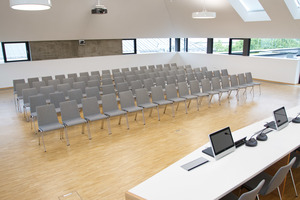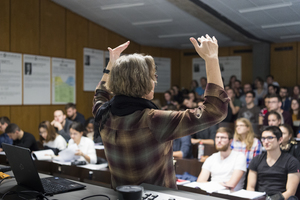Structure of KIT
Pursuant to Section 3 (2) of the KIT Act, KIT is required to issue joint statutes in accordance with the KIT Act. The "Joint Statutes of the Karlsruhe Institute of Technology (KIT)" (in German only) came into force on October 6, 2023. It consists of ten parts and regulates the structure of KIT. Among other things, the statutes describe the structure, organization, facilities, appointment procedures and honors.
An overview of important details on the structure of KIT can be found in the organizational chart of the KIT organizational structure and the KIT science organization.

Further information on the topic "Structure of KIT" can be found here:
Central Bodies of KIT
In addition to the Executive Board, the Central Bodies of KIT include the Supervisory Board and the KIT Senate.
Executive Board
The Executive Board manages KIT collegially according to the departmental principle and is called the "Executive Board". The Executive Board is responsible for all KIT matters for which no other responsibility is expressly defined in the KIT Act or the Joint Statutes, including planning the structural and infrastructural development of KIT. The Executive Board has six full-time members and consists of the Chairman of the Board (President), a Vice-President for Research, a Vice-President for Higher Education and Academic Affairs, a Vice-President for Digitalization and Sustainability, a Vice-President for Finance, Human Resources and Infrastructure, and a Vice-President for Transfer and International Affairs.
Supervisory Board
The Supervisory Board is responsible for the development of KIT and supervises the legality, expediency and economic efficiency of the Executive Board's management. Its tasks include, in particular, the election of the full-time members of the Executive Board, the adoption of the Structural and Development Plan and the planning of structural development.
KIT Senate
In accordance with the KIT Act (KITG), the KIT Senate decides on matters of research, teaching, studies, and advanced training and education. In particular, the KIT Senate is responsible for confirming the election of the full-time Members of the Executive Board and for commenting on the Structure and Development Plan.
As outlined in Article 9 of the KIT Act (KITG) in conjunction with Article 3 of the Joint Statutes (GS), the Senate members elected from the groups of KIT Professors having Large-scale Research Responsibilities and University Responsibilities, academic employees, students, doctoral researchers, and other employees take part in the KIT Senate meetings. By virtue of office, the President, the Executive Board Member responsible for Business and Finance, another Vice-President, a Head of Division, one of the Equal Opportunities Commissioners, and one representative of the Staff Council are members of the KIT Senate. Other KIT Senate members with advisory votes are the remaining members of the Executive Board and Heads of Divisions by virtue of office as well as a representative of the Students Union. A representative of the Young Investigator Network (YIN), a young researcher admitted for the doctoral procedure, two students, and the representative of KIT in the Supervisory Board take part in KIT Senate meetings as guests without a vote. In addition, the KIT Senate can admit further guests to a single meeting or to all meetings held during the term of office.

Divisions of KIT
The Divisions of KIT are organized by discipline and bundle research, teaching and innovation of the institutes, KIT Departments and Helmholtz programs assigned to them. Five Divisions are essentially based on the KIT institutes executing research, teaching, and innovation work. University education of the Divisions is organized in KIT Departments, Program-oriented research is organized in Helmholtz programs. The scientific disciplines of KIT are divided into five divisions.
Each division has a full-time division head who is supported by a Division Council. The Head of Division is elected for a period of five years by the Division Council in agreement with the Executive Board on the recommendation of a search committee. In addition to chairing the Divisional Council, he or she is also responsible for representing the division internally, in particular vis-à-vis the Executive Board, and externally, in particular on Helmholtz Association committees.

KIT Departments

At KIT, studies, teaching and academic affairs take place at eleven KIT Departments. The KIT deans report to the Vice-President for Higher Education and Academic Affairs.
The Strategic Controlling and Reporting Department of the Executive Office and Strategy Business Unit coordinates the allocation of funds to the KIT Departments.
Research Structures
University and program-oriented research takes place in the institutes of the individual divisions. An overview of the institutes at KIT can be found here.
Currently, nine KIT Centers coordinate cross-divisional research and innovation topics and promote interdisciplinary cooperation at KIT.
In the past funding period (POF III, 2015 - 2019), KIT participated in thirteen research programs in the four research fields "Energy", "Earth and Environment", "Key Technologies" and "Matter" of the Helmholtz Association and continued to operate three large-scale research facilities.
In the current fourth phase of program-oriented funding (PoF IV, 2021 - 2027, further information can be found here), KIT is participating in eleven research programs in four research fields. KIT operates the Grid Computing Center Karlsruhe (GridKa) as a large-scale research facility.

Further information on the research structures at KIT can be found here.
